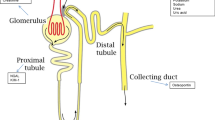Abstract
Background. In patients with congestive heart failure (CHF), the pathogenic role of angiotensin II in the development of cardiovascular death has widely been accepted. To study the pathophysiological mechanisms of CHF-associated renal damage, we examined urinary albumin levels as a clinical marker of glomerular hyperfiltration and sclerosis, which may be attributed to the upregulated function of angiotensin II.
Methods. Twenty outpatients with mild to moderate CHF without renal failure were examined. They were treated with various combinations of angiotensin-converting enzyme inhibitors (ACEI), (n = 9), calcium antagonists (n = 9), β-blockers (n = 6), and diuretics (n = 12). Urinary (u-) levels of albumin, N-acetyl-β-d-glucosaminidase (NAG), and transforming growth factor β-1 (TGF β1), and circulating levels of endothelin-1 (ET-1) and tissue inhibitor of metalloproteinase-1 (TIMP-1) were measured and examined in relation to various clinical parameters and the mode of treatment.
Results. (1) CHF patients showed significantly higher mean levels of u-albumin, u-NAG, u-TGF β1, plasma ET-1, and serum TIMP-1 than normal controls. In an age-matched comparison, the u-albumin levels in CHF patients were as high as those in diabetic patients without overt nephropathy and hypertension. (2) The u-albumin level tended to correlate with the u-NAG level (P = 0.051), however, there was no patient with high u-NAG in the subgroup with negative u-albumin levels. (3) The u-albumin level, like the u-TGF β1 and serum TIMP-1 levels, showed a significant positive correlation with the mean arterial pressure (MAP) level (each, P < 0.05), and showed slight, but nonsignificant correlations with the u-TGF β1 (P = 0.08) and serum TIMP-1 levels (P = 0.06). (4) The patients treated with an ACEI showed significantly lower levels of u-albumin (P < 0.01) and serum TIMP-1 (P < 0.05) than those not treated with an ACEI. Treatment with an ACEI tended to decrease positivity for u-TGF β1 (P = 0.09).
Conclusions. The correlation between MAP and u-albumin levels and the ameliorative effect of ACEI on u-albumin excretion suggest that urinary albumin excretion may be caused by a glomerular hyperfiltration mechanism produced by both preloading of the systemic blood pressure and afterloading by angiotensin II-mediated constriction of efferent arterioles. In addition, the suppressive effects of ACEI on u-TGF β1 and serum TIMP-1 levels suggest that angiotensin II may accelerate TGF β1-mediated tissue remodeling, including nephrosclerosis, in CHF.
Similar content being viewed by others
Author information
Authors and Affiliations
Additional information
Received: February 21, 2001 / Accepted: October 31, 2001
About this article
Cite this article
Matsushima, H., Yoshida, H., Machiguchi, T. et al. Urinary albumin and TGF β1 levels as renal damage indices in patients with congestive heart failure. Clin Exp Nephrol 6, 21–29 (2002). https://doi.org/10.1007/s101570200003
Issue Date:
DOI: https://doi.org/10.1007/s101570200003




